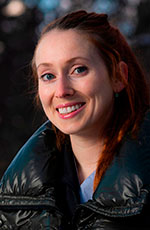Repairing a baby’s abnormal skull is a delicate balance between art and science that has to be decided before the first cut is ever made in corrective surgery. Now skilled surgeons have more tools to work with before gowning and gloving up, thanks to Émilie Robertson’s research.
Robertson, a medical resident in plastic surgery who graduates Nov. 20 from the University of Alberta’s Faculty of Rehabilitation Medicine with a master’s degree in rehabilitation science, devoted her thesis to developing virtual tools that can help predict the best way to correct a condition called craniosynostosis.
The birth defect – which causes the bones in a baby’s skull to fuse too early, forming a misshapen head – affects up to one in 1,000 infants and can lead to brain impairment and visual problems.
Adding to the toolbox of automated surgical planning means a better experience for the babies and their families, which is what inspires Robertson.
“If there’s any way to improve the process and make it less terrifying for families, that’s the goal I’m aiming for.”
Robertson, who has also earned an undergraduate degree from the U of A’s Faculty of Science and a medical degree from the Faculty of Medicine & Dentistry, explains her work and her future plans as she graduates.
What tools did you create through your research?
My work focused on pre-operative planning and involved three tools. I created a Deformity Index that can be used to measure the severity of the abnormality in unicoronal synostosis, a subtype of craniosynostosis, to determine how much better we can make a patient’s skull in terms of reconstruction. There’s also new data about perceptions of the general public, which helps surgeons determine meaningful targets when determining how to reconstruct a patient’s skull.
The third tool is what we hope will eventually be a fully automated, user-friendly virtual workflow using CT head scans to pre-operatively plan the surgery step by step. Currently, the process can be time-consuming and the software expensive, so I’m working with computer scientists in the Faculty of Science to develop computer algorithms to help with that.
We’re still experimenting, but I’ve used the Deformity Index to measure pre- and post-operative success on patients, and there’s a new pediatric surgeon coming on board who’s keen to work with pre-operative plans. It’s nice to know I have the tools and we can see what works and what doesn’t.
How can these tools help surgeons do their job?
One of the big advantages is more efficiency – we can shorten surgical times and reduce the subjectivity of decision-making. The process of repositioning the pieces of the skull to a normal shape can take a lot of time. Having an exact plan mapped out really lets the surgical team work with precision.
What excites you about the field of plastic surgery?
It’s a very creative field – we have an endless number of difficult problems that we apply our skills towards solving. It’s not a cookie-cutter specialty. I also have an interest in fashion design, so the design component is similar between the two domains. It’s very hands-on and I’m a very hands-on person.
How has your work at the U of A been rewarding for you?
It’s the multidisciplinary nature of the team I find rewarding. In surgical design and simulation, you need to work with multiple people in different faculties. Having this big team and seeing what we come up with when we work together is really interesting. We’re dealing with problems that are difficult to solve without combining expertise from different areas, and the U of A has the ability to be on the frontier of this type of innovation.
How did your U of A education set you up to succeed?
Completing the Specialism in Surgical Design and Simulation program through the Faculty of Rehabilitation Medicine and the Institute for Reconstructive Sciences in Medicine (iRSM) gave me a set of very practical skills that are going to be helpful in my practice as a surgeon.
What’s next for you?
After I finish my medical residency, my plan is to pursue a fellowship in craniofacial surgery and then continue research in this field. I’d love to come back and work at the U of A and continue working with iRSM. I’d also like to branch out to other areas of plastic surgery and apply surgical planning technology to soft tissue reconstruction and hand-wrist surgery, for example.
| By Bev Betkowski
This article was submitted by the University of Alberta’s online publication Folio, a Troy Media content provider partner.
The views, opinions and positions expressed by columnists and contributors are the author’s alone. They do not inherently or expressly reflect the views, opinions and/or positions of our publication.


